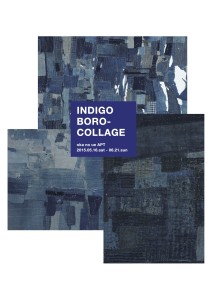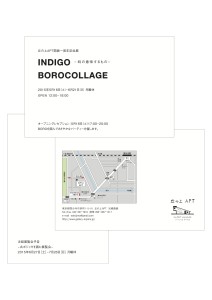ご来場ありがとうございました。展覧会の様子はこちらからご覧頂けます。
兒嶋画廊所蔵の襤褸を公開いたします。
所蔵品の一部はこちらの Indigo Borocollage でもご覧頂けます。
会場:丘の上APT/兒嶋画廊
東京都国分寺市泉町 1-5-16
Tel. 042-207-7918
会期:2015年5月16日(土)〜6月21日(日) *月曜定休
時間:12時〜18時
ボロと土 藤森照信(建築家・建築史家)
この世と自然界に存在するあらゆる物は、長い長い風化の果てに二つの物質に収束してゆく。
一つは土、もう一つは炭。
鉱物質は、焼かれ砕かれ擦られた果てに土になり、有機質は炭と化す。
ただし酸素と熱が同時に作用すると、炭も土となる。
物質は、長い長い時間の果てにすべて土に帰るのだが、
その土というものの視覚的効果について、実はあまり語られてこなかった。
土を焼成して生まれる焼き物ほどにも語られていないし、
土を素材にした美術作品をこう思い浮かべても、関根伸夫の<位相―大地>がただ一つあるばかり。
物質が、材料が、素材が、あるいは工芸品や建築物や美術品が、長い時間の中で、
人によって使い古され、自然によって風化させられた果てに、何を喪い何を得るのか、
土の問題同様、これまで放置されてきたテーマといっていいように思う。
こと土については、私自身の建築作りの中であれこれ試み、今は一つの認識を得ている。
その認識とは、
“土は見る人の視線をスポンジのように吸収し、印象を返してくれない”
土を見ても、それがどのような形であろうとも、印象が残らない。
人がどう働きかけようが働きかけまいが、土は土のままそこにずっとある。
土は自然だけでなく人の意識まで吸収する力がある。
その証拠に、土を相手にしていると誰でも無言になる。
土についてこのような認識を得た後、土の本質と時間の本質は通底していると思った。
そう思ったのは、骨董品と建築空間の関係について考えている時で、
なぜか骨董品は、どの時代にどの国で制作された品であれ、
古い民家であろうが清楚な数寄屋であろうが、はたまた現代の白いモダンな空間であろうが、
どこに置こうと違和感なく納まるのはなぜなのか。
おそらく、時間の経過が、時間による古びが、
その品が制作された時点で帯びた時代性や地域性や宗教性や美意識などを無化してしまったからに違いない。
時間を帯びるとあらゆる作品の印象は土に近づく、といえるのではないか。
兒嶋さんが長らく収集してきたボロい作業着を手にした時、不思議な感覚がした。
きれいとか汚いとか、素晴らしいとかイマイチとかの印象が湧かず、しかし、心が安らぐ。
手にしたボロ着の色とか糸の縫い目とかを追っていると、まるで土をこねている時のように言葉が消えてゆく。
日本には古くから何かの事情で断片化した古裂(こぎれ)を鑑賞するという世界にも珍しい習慣があるが、
おそらく、その古裂のもう一踏み奥にあるのがボロの領分なのだろう。
布でいえばボロ、建築でいえば廃墟、こうした領分への関心がどうして21世紀の初頭に湧いてくるのか。
ブルー・ジーンズの問題と通底しているに違いない。
かつて幌馬車で草原を進んだ西部開拓者が、
一番安く染められた青い幌の布が古びると作業ズボンに仕立て直したのが始まりというが、
なぜか文明化と工業化が進むにつれ、アメリカを越えて広がり、今や世界の若者の定番となり、
さらにナゼか穴を開け、使い古しのボロ化へと進んでいる。
日本における作業着の代表“藍染め”は、かつて民芸運動で注目されたが、
あの運動はボロに価値を見出したわけではなかった。
兒嶋さんが長らく注目して集めてきたのは、もっぱら藍染めのボロ着である。
藍染めという点では共通しているが、果たして民芸とボロの間に血脈はあるのか。
これにボロいブルー・ジーンズが加わるとどうなるのか。
ボロの謎は深まるばかり。
[了]
Boro* and Soil by Terunobu Fujimori
Everything in nature, so long as it exists in this world, is doomed to end up two substances after weathering of long long time.
One is soil and the other is charcoal.
Mineral matter is burned and crashed and becomes soil in the end. Organic matter also becomes charcoal.
With simultaneous effect of oxygen and heat, charcoal becomes soil, too.
Matter ends up as soil after good long period of time. Visual effect of soil has not been talked about frequently before.
Although that of pottery, which is burned from soil, has been discussed more frequently.
If I try to imagine any work of art. which uses soil as material, I can find one case only.
That is <Phase -The Earth> by Nobuo Sekine.
[Matter, Material , Stuff] or [Craft object, Architecture, Work of art] ,these are going to be worn and torn by man,
and weathered by nature in a long period of time.
We have not paid much attention on what they lost and gained.
This subject has been abandoned, just like we have not paid attention on soil.
As for soil, I got one certain view through my trials and errors for building works.
That is “Soil absorbs sight of man just like a sponge and does not reflect any impression.”
We watch soil and get no impression regardless its shape. Soil remains there as it is, no matter how hard we try to work on it.
And the results still remains the same in case we do not work at all.
Soil has power to absorb not only nature but also human consciousness. I can show you proof.
[Everyone becomes silent when one is working with soil.]
After getting this view, I was convinced that something is common between essence of soil and that of time.
This view came to my mind when I was thinking about relation between antiques and space in architecture.
Why can antiques harmonize themselves to any space regardless time and place they were born?
In an old private house or in a neat and clean tea-ceremony arbor, or even in modern white space, they fit well.
Why?
Perhaps a lapse of time and its associated maturity have invalidated inborn traits of its time, of its place, of its religion and of its aesthetic.
We can say, impression of any works will get closer to that of soil as time passes.
When I touched the Boro of working clothes which Mr.Kojima has collected over a long period of time, I felt something mysterious.
That was different feeling from [clean or dirty], or [great or shabby].
It was something peaceful.
As I checked colors and seams, I did not say a word, just like the way I knead soil.
In Japan, there has been unique custom to appreciate leavings of beautiful textiles which was segmented by certain reasons.
These leavings are called [Kogire]. Perhaps Boro(rag) is one step forward from Kogire.
In the early 21st century, we have extended our concern to Boro at textile, and to ruins in architecture.
Why did these things happen? I think something is common with the case of Blue-Jeans.
Pioneers marched plains on covered wagon ,whose hood was dyed in the cheapest color of blue.
Old hood was recycled as working pants later.
This is the origin of blue-jeans. As civilization and industrialization flowed over United States,
young folks of the world take jeans as standard clothe.
And now, by unknown reason,.they intentionally wear holes on the jeans.
It seems Jeans are taking same road with that of old Boro..
The most popular color of working clothe in Japan was dark blue and this color got attention in the Japanese Fork Art movement.
However Boro was not fully appreciated in this movement.
Mr.Kojima has been collecting dark-blue Boro. Dark-blue is common among two parties.
Can we find blood relationship between Folk Art and Boro?
If we add old blue-jeans to this relation, then what will happen?
Now I have deeper mystery.
by Terunobu Fujimori
Architect and Architectural Historian


